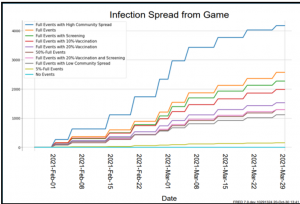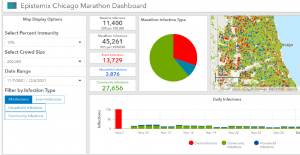Epistemix Software Modeling Offers Insights on Fan Attendance Variables on COVID-19 Infection Rate
Story Highlights
The return of fans to sports events can’t come soon enough for teams and leagues at all levels and Pittsburgh-based Epistemix hopes it can help make that day arrive safely. Having developed software at one of the four NIH Centers of Excellence for modelling Infectious Diseases in the United States, Epistemix can simulate the current epidemic in parallel with various scenarios to show where fans will come from, where they will stay, and more. The goal is to give league and team decision makers a better sense of when they can hold an event that brings in the desired percentage of fans.

With software modeling Epistemix can predict various attendance scenarios so that even organizers can understand the impact the event will have on infection rates.
The world has seen many companies start up in response to COVID-19 but Epistemix isn’t one of them. The company has been involved with modeling pandemics for more than a decade and the software was born out of the University of Pittsburgh where Epistemix President Dr. Don Burke was Dean of the Graduate School of Public Health (he also led countless infectious disease research efforts for HIV/AIDS, Dengue, Zika, H1N1 to name a few, and vaccine development and clinical trial sites around the world while at the Walter Reed Army Institute of Research and Johns Hopkins University).
In his role as Dean at Pitt, Dr. Burke created the Public Health Dynamics Laboratory and he invited John Grefenstette, a senior computer scientist at the Navy Center for Applied Research in Artificial Intelligence who he knew from building computer simulations for HIV/AIDS insights earlier, to work together on the FRED (Framework for Reconstructing Epidemiological Dynamics) modeling platform. That platform allows for conditions like behaviors, attitudes, economic status, and more impact infection rates.
John Cordier, Epistemix, CEO, says that software been used to improve the way public health can be practiced and was licensed to Epistemix to allow for it to have a greater impact.

A dashboard makes it easy to visualize where infections will spike relative to an event.
“We have a digital twin of the entire United States,” he says. Every person, every school, every workplace is in the system and Epistemix can work with a team, league, school or other entity to bring together attendee demographics with levels of immunity to figure out at what point different levels of capacity can be safely allowed.
“We want to make going to a game as safe as going to the grocery store with your mask on,” says Cordier.
Among the questions the system can answer are:
-How many fans can safely attend at a given time
-How the rollout of a vaccine change the attendance cap
-Risks for those in the local area and employees
-How things like social distancing in the venue will impact the size and location of fans.
Once a client has signed up (users of the software sign up for a year-long contract that includes a consultant to help run and re-run simulations) it takes about two weeks to begin running simulations and see how changing various parameters impacts the ability to hold an event.
“Right now, our projections are within a 90% confidence interval,” he says. “Starting with the digital twin of the actual population, rather than just saying ‘oh well, here are the numbers and we’re going to run some algorithms to fit to the trajectory’ is what makes us different.”
Also making it different is the ability to explore the impacts of bars and restaurants opening around a stadium or arena as odds are those businesses will also return and will also have an impact on the spread of COVID-19 depending on the local immunity level.
“We provide some certainty and data around the target date and conditions to bring back fans so an organization can focus their energy and efforts rather than spinning a bunch of plates and trying to figure out when the epidemic is going to be like this or that in and when it’s safe to open.”
